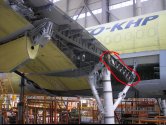Aaaanyway.
Huitong's blog has image of J20 serials from various plaaf units.
9th brigade has serial codes documented in a range from 01 to 27.
1st brigade has serial codes from 02 to 18.
Three more brigades have just one serial documented.
So... would the range from 02 to 18 suggest there's not many more than 18 planes in said brigade?
Or would the 01 to 27 range suggest there's more than 24 planes in said brigade?
How often does PLAAF use gaps in their serials on purpose?
There's also the example of J16.
There the 98th brigade has serials document in a range from 03 to 33 AND there's another serial number which would correspond to 96. Which is quite weird.
The 7th brigade has serials ranging from 01 to 28 documented.
The 40th brigade has serials from 01 to 24 documented.
The 3rd brigade has serials from 01 to 29. Though there's a huge gap in between, from 07 to 20.
Assuming all those J16 brigades don't have gaps (ignoring the peculiar 96 serial for the moment) that would suggest most J16 brigades (if not all) have around 30 or even little over 30 planes each.
So with that precedent, it's also plausible J20 brigades could be bigger. It would appear plausible that current brigades featuring modern planes are made to be larger and that they have more planes. But do we have other indications pointing in that direction, that J20 brigades are in fact quite large?
AIUI, the tentative expectation and hypothesis for the last few years, is that a full outfitted frontline fighter air brigade has 30 aircraft, including for J-20s.
Given we know that the PLA are deliberately aware and sensitive of giving away serial numbers of new aircraft units, especially for more newer and more strategically significant aircraft like J-20, it may be that the first pictures "proving" that a newly outfitted J-20 brigade has received its late 20ish or 30th airframe serial, may be many months or even years after the fact.

